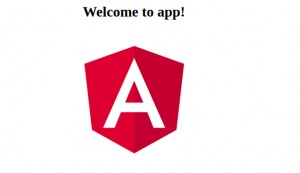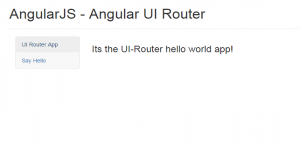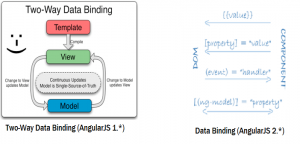Tag Archives: angularjs
How to Upgrade Angular 4 to Angular 5 Apps
This blog represents steps required to upgrade or update or migrate existing Angular 4 apps to Angular 5 apps. Greater details can be found on Angular 5 announcement blog. I must tell you that upgrading from angular 4 to angular 5 is not like the one represented below (from AngularJS to Angular 2.* and later versions). In this post, you will learn about some of the following: Preparation for upgrading from Angular 4 to Angular 5 Running the upgrade activity Post-upgrade activities Testing the Angular 5 App Upgrade/Update Preparation from Angular 4 to Angular 5 Apps The following are some of the activities which are recommended before the update/upgrade is done: Rename …
Angular Unit Testing Interview Questions – Set 1
This quiz provides basic questions in relation to Angular unit testing. The following are some of the concepts which are covered in this quiz. Angular unit testing fundamentals Angular unit testing tools (Karma & Protractor) Angular testing utilities – TestBed [wp_quiz id=”5463″]
Angular – How to Get Started with Unit Test
This blog represents code sample on how to get started with unit test in an Angular app (Angular 2/Angular 4). The code sample shown below could be used as a template for creating a unit test spec for any component. Unit Test Code Sample for Angular Component Pay attention to following two points: Need to declare component which needs to be tested; In the code shown below, it is the SignupComponent which is tested. Note that SignupComponent represents template-driven form for Signup. In another example, the unit test for AppComponent is shown. Need to declare the modules which are required for testing the component; In the unit test code given …
Configure Angular Route Definitions – Part 2
In this blog, we will learn about how to configure Angular route definitions in an Angular app by defining route definitions as a separate module at the root level. Again, this is not the most effective way of defining Angular route definitions. In third part of this series, we will learn about how to define route definitions as part of separate feature modules, and, not at the root level. In the previous blog in this series, we learned about the most trivial way of configuring route definitions in an Angular app. As the app starts getting complex, one needs to use routing concepts such as child routes, guards, resolvers, and so on. …
Angular 2 – How to Secure Apps from CSRF/XSRF Attack
This blog represents concepts and code samples in relation with securing Angular apps from from CSRF or XSRF attack. The following points are covered: Different types of CSRF/XSRF tokens Angular’s default CookieXSRFStrategy Server-side processing of XSRF tokens Angular custom CookieXSRFStrategy implementation Different Types of CSRF/XSRF Tokens CSRF/XSRF tokens can be of following different types: Per-session token: The token is generated once per session. With each request, the token is sent. Server verifies the correctness of the token and validity in terms of whether the token is expired or not. Per-request token: The token can be generated for each request and later verified and validated. With Angular apps, any one of …
Angular 2 – How to Configure Route Definitions – Part 1
This blog series would be used to describe different techniques which can be used to configure route definitions in Angular apps. The routing can be defined based on following three patterns: Route definitions within AppModule Routing defined as a separate module at app root level Routing module defined within feature modules (recommended for enterprise apps) In this blog, we will learn different aspects related with creating route definitions within AppModule. The most simple way of configuring route definitions is creating route definitions within AppModule file such as app.module.ts which is found at root level. This technique can be used for only learning purpose. When creating complex or enterprise apps, this …
Angular – How to Create Your First Angular App

This blog represents concepts and commands which would help you setup development environment to build Angular apps. Introduction to Angular CLI Angular CLI is a command line interface for Angular. With Angular CLI commands, the following are some of the key functionality which can be achieved using Angular CLI commands: Create an application that follows best practices recommended by Angular. ng new command is used. Test the app locally as you develop. ng serve is used. Greater details can be found on this page, Angular CLI. The documentation in relation with Angular CLI can be found on this page, Angular CLI Documentation. Install the Angular CLI The following command can …
Angular – Reactive or Template-driven Forms?
This article represents quick introduction to two different kind of forms which can be created in Angular 2 or Angular 4. Please feel free to comment/suggest if I missed to mention one or more important points. Also, sorry for the typos. Following are the key points discussed later in this article: Template-driven forms Reactive forms Template-driven forms Template-driven forms are the most trivial type of form that can be quickly created in Angular 2. Following are key aspects of creating template-driven form. These forms are asynchronous in nature. These forms require inclusion/import of FormsModule in the root module, AppModule which is placed in the root folder of the app. Following …
AngularJS, Angular-UI Router Hello World Starter App – Code Sample

This article represents code samples to get started with an AngularJS app with Angular UI-Router and Bootstrap. Please feel free to comment/suggest if I missed to mention one or more important points. Also, sorry for the typos. Code Example – AngularJS 1, Angular UI-Router, Bootstrap Pay attention to some of the following in the code given below: Angular-UI router state information is used to associate links with templates Angular-UI code with within tag element “ui-view” to load specific views <!DOCTYPE html> <head> <title>My AngularJS App</title> <link rel=”stylesheet” href=”https://maxcdn.bootstrapcdn.com/bootstrap/3.3.7/css/bootstrap.min.css” integrity=”sha384-BVYiiSIFeK1dGmJRAkycuHAHRg32OmUcww7on3RYdg4Va+PmSTsz/K68vbdEjh4u” crossorigin=”anonymous”> </head> <body ng-app=”myApp” class=”container”> <div class=”page-header”> <h1>Angular 1 – Angular UI Router</h1> </div> <div class=”container-fluid”> <div class=”row”> <div class=”col-sm-3 col-lg-2″> …
Ionic – How to do Check All with Ion-Checkbox
This blog represents code sample to achieve “Check all” or “Select all” using ION-Checkbox. AngularJS/Ionic Controller Code to Check All Say, you have a list of contacts (name) with check boxes. What you want is to achieve “check all” when you check one checkbox. $scope.allcontacts is a temporary object to capture the checkbox checked value. $scope.allcontacts = {}; $scope.allcontacts.checked = false; $scope.checkAll = function() { if ($scope.allcontacts.checked) { $scope.allcontacts.checked = true; } else { $scope.allcontacts.checked = false; } for (var i=0; i < $scope.contacts.length; i++) { $scope.contacts[i].checked = $scope.allcontacts.checked; }; }; HTML Code including Ion-Checkbox to Achieve “Check All” <ion-list> <ion-checkbox class=”item-checkbox-right” ng-model=”allcontacts.checked” ng-checked=”allcontacts.checked” ng-click=”checkAll()”> All Contacts </ion-checkbox> <ion-checkbox ng-repeat=”contact …
Angular 2 – Add Row Code Sample
This article represents concepts and code sample around how to add a row in a tabular dataset in Angular 2 apps. Please feel free to comment/suggest if I missed mentioning one or more important points. Also, sorry for the typos. Following are the key points described later in this article: Add Row – Concepts Add Row – Code Sample Add Row – Concepts Following are some of the key points to be noted in relation to adding a row in an Angular 2 app. Define a component, AddRowComponent, and bootstrap this component. Take a look at the code below on how to bootstrap the component. Define a selector add-rows with …
Angular 2 – Two Ways to Initialize Component Properties
This article represents two different ways in which Angular 2 components properties can be initialized. Please feel free to comment/suggest if I missed to mention one or more important points. Also, sorry for the typos. Following are two different ways to initialize the component properties. In the example below, component’s property is initialize through variable assignment. Take a look at the code “name = ‘Calvin Hobbes’”. This approach is sometimes preferable because it makes code easy to read and also, there will be lesser code to write. import {Component, View} from ‘angular2/core’; @Component({ selector: ‘user’ }) @View({ template: ‘{{name}}’ }) export class UserComponent { name = ‘Calvin Hobbes’; } In the …
Angular 2 – Two Ways to Pass Data to Components
This article represents concepts and code samples in relation to how one could pass data from one component to another in an Angular app. Please feel free to comment/suggest if I missed mentioning one or more important points. Also, sorry for the typos. As Angular is primarily based on components and components interaction, it is important to understand how data is passed from one component to another. Data is passed between the component using property bindings. Take a look at the syntax below: In above syntax, user component’s property “value” is bound to “user” property of the parent component. The data type of the bound property needs to be matched. Thus, if …
Angular 2 – Parent-Child Components Explained with Code Examples
This article represents concepts and code examples for creating parent-child components. Following image represents the view which is referred in the code samples below. Please feel free to comment/suggest if I missed to mention one or more important points. Also, sorry for the typos. Following is explained later in this blog. A parent component, HelloWorld and the interaction with Child Component, UserComponent A child component, UserComponent An interface User Parent Component, HelloWorld, interaction with Child Component, UserComponent A parent component, HelloWorld, represents the view consisting of Hello message and a textfield for user to interact with the view. The Hello message looks like <h1>Hello, <user [value]=”user”></user>&t;/h1>. Notice that the …
Angular 2 – Data Binding to Accommodate Component Relationships

This article represents concepts and related code samples in relation with data binding in Angular 2 vis-a-vis component relationships. Those with prior experience of ReactJS which propagates one-way binding would find it easy to understand and consume. 🙂 AngularJS 1 bragged about the two-way data binding very much. However, Angular 2 decided to promote one-way data binding (as like ReactJS) and, two-way data binding is considered only as a special case. Please feel free to comment/suggest if I missed to mention one or more important points. Also, sorry for the typos. Following are the key points described later in this article: Two-way Data Binding in AngularJS 1 Data Binding in …
5 Reasons Angular 2 Hello World is Trickier than AngularJS 1 Hello World
This article represents my thoughts on why Angular 2 apps is trickier to write than AngularJS 1 apps. I have represented the Hello World code to demonstrate the same. Please feel free to comment/suggest if I missed to mention one or more important points. Also, sorry for the typos. Following are the key reasons: Components Vs Controllers: In Angular 2 Apps, what is key is Components associated with a View. These components have got a selector, a View and a set of properties and methods encapsulated within a Class. In AngularJS 1, it was all about Controllers having logic to interact with View. It was very easy to bootstrap AngularJS …
I found it very helpful. However the differences are not too understandable for me